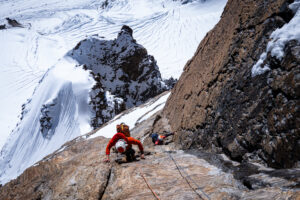A major snowstorm that lasted at least four days has dumped one to two meters of fresh snow on the Himalaya. The tonnage of powder may have damaged higher camps and buried ropes on the 8,000m peaks. Most of all, it has seriously increased the risk of avalanches on both the Nepali and Tibetan sides.
Nepal 8,000’ers
Most Manaslu teams summited last week, but some climbers are still awaiting their chance. Many of these are not using supplementary oxygen, so needed more time to acclimatize. Flor Cuenca, for instance, leads a no-O2 team of fellow Peruvian women. She says the weather is perfect today, but the snow on the mountain must stabilize before they dare venture up.
Meanwhile, on Dhaulagiri, the Russian team reported no avalanches at the icefall leading to Camp 1 yesterday. They planned to head up from Base Camp today. Before retreating to Base Camp to shelter from the storm, they reported they were ready for a summit push. But is Dhaulagiri ready, too?
On the south side of Cho Oyu, Russia’s Andrey Vasiliev is returning to Camp 1 to repair any storm damage. He and his companions had retreated to Gokyo village as the storm approached.

Snow around the Gokyo Lakes, near the south side of Cho Oyu. Photo: Andrey Vasiliev
Tibet 8,000’ers
On the north side Cho Oyu, guide Ulises Corvalan reports that after eight days of stormy weather, the mountain is loaded with two meters of fresh snow. Guides still have to fix ropes on the upper sections of the route and will likely have to re-fix some areas between Camp 1 and Camp 2.
We expect updates soon from Shisha Pangma, where windswept snow would have left the avalanche-prone upper slopes in a risky state. Shehroze Kashif’s tracker shows that he is moving from Base Camp to Advanced Base Camp today. Uta Ibrahimi was higher up, at 5,900m. It is not clear whether she is on her way to Camp 1 or is just exercising by breaking trail up through fresh snow, as she did yesterday.
“It’s too much snow, but we have hope,” she texted via InReach. Tracee Metcalfe, a member of Mingma G’s team, reports that they are in Advanced Base Camp today.






